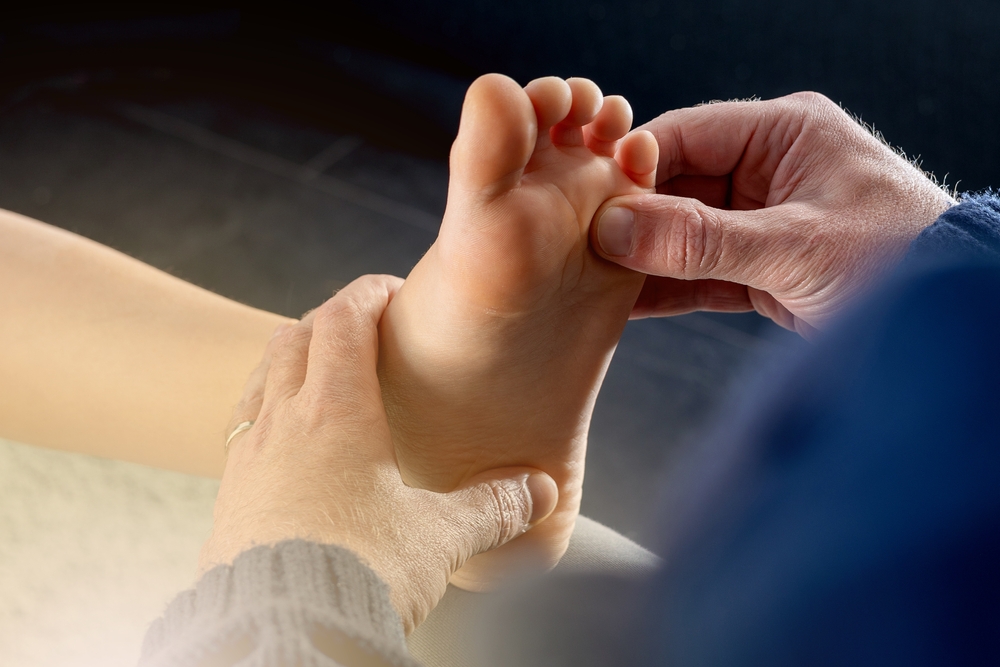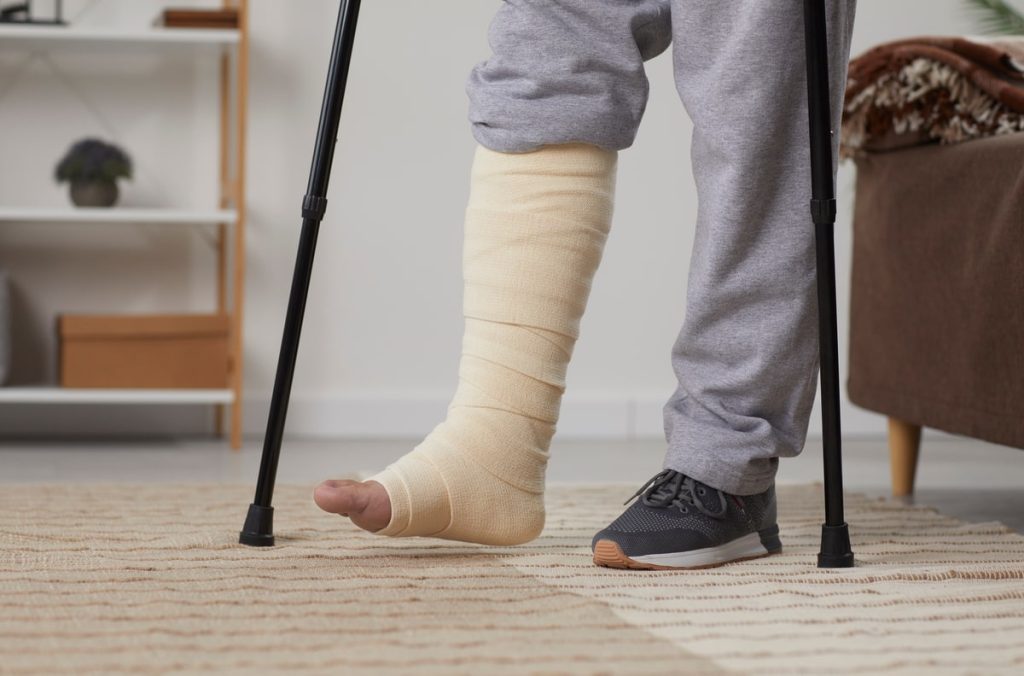Bunions, bony bumps that form at the base of the big toe, are not only a common foot deformity but also a source of significant discomfort for many. Understanding the journey from the initial diagnosis to full recovery is vital for those affected by this condition.
A bunion is a bony bump that forms on the joint at the base of the big toe, which is known as the metatarsophalangeal (MTP) joint. This deformity, medically termed ‘hallux valgus,’ arises when the big toe begins to lean in towards the second toe. The shifted position creates an enlargement of the bone or surrounding tissue, which later becomes the pronounced bump associated with bunions.
Causes:
- Genetic predisposition to certain foot types
- Mechanical imbalances of the foot and big toe joint
- Poorly fitted footwear, especially those with a narrow toe box and high heels
- Conditions like rheumatoid arthritis
Symptoms:
- Bony bump on the outside of the big toe joint
- Pain and tenderness around the joint, which may be persistent
- Swelling, redness, or soreness in the big toe area
- Corns or calluses often develop where the first and second toes overlap
- Stiffness and restricted movement in the big toe, potentially leading to difficulty walking
This blog post aims to guide patients through the often intricate process of treating bunions, providing them with the essential knowledge to make informed decisions and ease their path toward relief and healing.
 The Diagnosis Stage
The Diagnosis Stage
Proper diagnosis is the first step towards effective treatment. When individuals notice persistent pain or deformity in their feet, they should seek medical consultation. Individuals who experience bunion pain or notice the telltale bony bump should consult with a healthcare professional. During an assessment, a doctor will examine the big toe joint for signs of misalignment or arthritis and may recommend an x-ray to determine the degree of the deformity and to assess for coinciding issues like bone spurs.
The x-ray results help the doctor visualize the extent of the deformity and guide the treatment plan. Without appropriate diagnosis and treatment, bunions can lead to other painful foot deformities, such as hammertoe or the formation of a bunion on the little toe known as a “bunionette.”
Healthcare providers will perform a thorough physical examination, possibly including an X-ray, to assess the severity of the bunion and rule out other conditions. Delaying treatment can exacerbate the problem, potentially leading to more severe complications.
Exploring Treatment Options
Several non-surgical treatments can provide considerable relief before considering surgery. Upon diagnosis, treatment typically begins with conservative non-surgical methods aimed at relieving bunion pain and slowing the deformity’s progression. Orthotic devices, or shoe inserts, can be custom-fitted to help reposition the big toe and alleviate pressure on the big toe joint. Padding, taping, or splinting may also provide support and reduce discomfort during activities.
Medical practitioners often suggest wearing comfortable shoes with a wide toe box to provide the big toe with the necessary room and advise against tight, narrow footwear or high heels that can exacerbate bunion pain and progression. Over-the-counter bunion pads can cushion the bony bump and minimize pain from friction with shoes.
In some cases, medications, such as nonsteroidal anti-inflammatory drugs (NSAIDs), can help manage the pain and swelling associated with bunions. Injections of corticosteroids are sometimes recommended for severe pain, particularly when it’s linked to joint inflammation or arthritis.
When these options fail to provide adequate relief or if the bunion interferes with daily activities, bunion surgery might be considered. Surgery is typically reserved for cases where the pain is chronic and debilitating or if there are significant deformities or complications such as arthritis. Different surgical procedures exist to correct bunions, tailored to the specific needs of the patient’s foot anatomy and the severity of the bunion.
Each of these treatment approaches, from well-fitting shoes to customized orthotics and, in certain instances, surgical intervention, aims to improve foot function, minimize pain, and slow the progression of hallux valgus deformity. Consulting with a healthcare provider is the best way to determine which treatment may be most beneficial for an individual’s unique situation.
 The Surgical Journey
The Surgical Journey
Surgical options vary depending on the severity of the bunion and the patient’s overall health. The day of surgery will typically involve anesthesia and may require a brief hospital stay. Postoperative recovery then focuses on healing and gradually increasing foot mobility.
Pre-Surgical Preparation
- Understanding Severity: Surgeons evaluate the severity of the bunion by x-ray images to determine the most appropriate procedure for bunion correction surgery.
- Choosing the Right Procedure: Depending on factors like the angle between the big and second toe and the overall foot structure, different surgical methods such as osteotomy, fusion, or exostectomy may be considered.
- Patient Education: Patients are informed about what to expect from the surgery, including potential risks and the anticipated recovery timeline.
Day of Surgery
- Anesthesia: Depending on the extent of the bunion correction required, surgery may be performed under local or general anesthesia.
- The Procedure: The chosen surgical technique is executed to correct the joint at the base of the big toe, realign the big toe, and relieve symptoms caused by the bunion.
Post-Surgical Care
- Immediate Care: Post-operation, focusing on managing swelling and pain with appropriate pain relievers and anti-inflammatory medications.
- Hospital Discharge: Instructions are provided on care at home, including wound care and the use of crutches or special footwear.
Post-Surgical Recovery at Home
Once home, patients must adhere to their surgeon’s aftercare instructions. Managing post-operative pain is important, often involving prescribed pain relievers. Creating a comfortable home environment that facilitates rest and limits movement is crucial for proper healing. Regular follow-up appointments are imperative to monitor healing and address any concerns.
First Few Weeks
- Pain Management: Utilizing prescribed pain relievers to manage post-surgical discomfort.
- Rest and Elevation: Keeping the foot elevated to reduce swelling and pain, crucial in the first few weeks after surgery.
- Wound Care: Proper care of the surgical site to prevent infection.
Mobility and Footwear
- Gradual Weight-Bearing: As recommended by the surgeon, patients may gradually begin putting weight on the foot, initially using crutches or a walker.
- Special Footwear: To prevent bunions from recurring and ensure comfort, transition from surgical shoes to shoes that don’t fit tightly and do not pressurize the toe area.
Long-Term Care
- Monitoring and Follow-ups: You should have regular check-ups with the surgeon to monitor the healing process and ensure that the proper alignment of your big toe remains intact.
- Preventive Measures: Adopting lifestyle and footwear changes to prevent bunions and related foot issues from developing in the future.
Rehabilitation and Physical Therapy
Recovery timelines vary, but most patients can expect a gradual return to normal activities. Physical therapy plays a crucial role in regaining strength and mobility in the foot. Exercises designed by a physical therapist will aid in a smoother and more effective recovery process.
Initial Stage
- Gentle Exercises: Initiation of mild exercises to improve joint mobility without surgery, which is crucial for the recovery of the range of motion.
- Toe Spacer Usage: Employing a toe spacer can help in maintaining proper alignment between the big toe and the second toe.
Progressive Rehabilitation
- Strengthening Exercises: As healing progresses, exercises that strengthen the muscles around the ball of your foot can be incrementally introduced.
- Flexibility Training: Focused on restoring the full function of the big toe and ensuring that joint flexibility at the base of your big toe is regained.
Long-Term Physical Therapy Goals
- Full Mobility Restoration: The primary goal is to restore full mobility and reduce pain and discomfort that people with bunions commonly experience.
- Preventative Strategies: Education on proper footwear and lifestyle choices to prevent the recurrence of severe bunion issues like tailor’s bunion.
By incorporating these systematic stages into the bunion treatment plan, individuals can effectively manage recovery after bunion correction surgery and take proactive steps toward preventing future foot health issues.
Post-recovery, patients must take preventive measures to avoid bunion recurrence. They should invest in shoes with suitable support, maintain a healthy lifestyle, and schedule routine podiatric visits to monitor foot health.
The journey from bunion diagnosis to full recovery requires understanding the condition, exploring treatment options, and adhering to postoperative care and physical therapy plans. With proactive management and healthcare professionals’ guidance, patients can confidently navigate their path to recovery.
It’s crucial to maintain a positive outlook throughout your bunion treatment journey. Recovery can be slow and at times, frustrating, but remember that each step is progress toward a life with less pain and more mobility. Celebrate the small victories, stay consistent with your treatment plan, and keep your sights set on the road ahead: a future of happier steps.
COMMITTED
TO EXCELLENT SERVICE
Our philosophy has been that the patient always comes first.
EMERGENCY OPERATOR
24 HOURS
Get emergency care from a specialist right from the start. Don’t go to an urgent care, ER or general doctor. Come straight the specialist.



